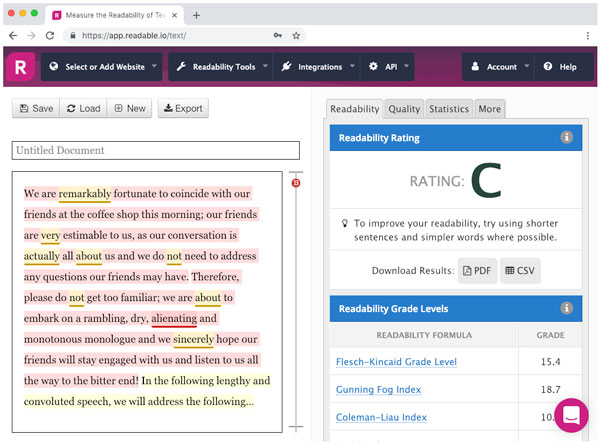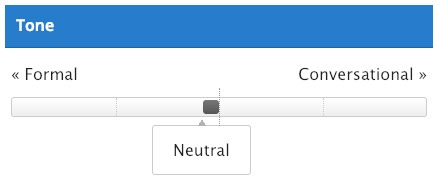Picture the scene. It's morning. We're sitting in two plush armchairs across from each other in a downtown coffee shop. The inviting smell of the coffee greets you and, as you bite into a warm croissant, you know you're starting the day right. You're having breakfast and catching up with a friend.
You expect small talk. You expect informal language. You're expecting us to connect in conversation, for me to address you and you alone. We should be on the same page and understand each other. These are social norms.
Avoiding eye contact, I set my coffee down, fold my arms protectively and say:
“We are remarkably fortunate to coincide with our friends at the coffee shop this morning; our friends are very estimable to us, as our conversation is actually all about us and we do not need to address any questions our friends may have. Therefore, please do not get too familiar; we are about to embark on a rambling, dry, alienating and monotonous monologue and we sincerely hope our friends will stay engaged with us and listen to us all the way to the bitter end! In the following lengthy and convoluted speech, we will address the following…”
This scenario would obviously be silly in real life, so why do we try to connect with people like this in blog posts?
Here’s what I did wrong:
- I used the first-person plural ‘we’, which is much more formal than using the first-person singular ‘I’
- I used unnecessary adverbs
- I used difficult words where I could’ve used simpler ones
- I used full words where contractions like ‘don’t’ would be more casual and approachable
- I made it all about me. I didn’t recognize that a conversation is a two-way street, so my conversational blog shouldn’t assume a faceless audience
- I used the word ‘therefore’ - way too formal. It’s not an essay
- I used lengthy sentences with multiple clauses. I wouldn’t speak like that
- My tone was too formal and dry
- I used an exclamation point where I didn’t really need to. It looks alarming rather than light-hearted and doesn’t translate well
- I show no empathy for my friend across the table. I’m alienating them with my impersonal tone
You only have a few seconds to grab your reader’s attention. For your reader to be engaged, you need to help them wake up and smell the content.
In a fast-paced and high-tech age, I know how tricky it can be to keep your content engaging, readable and approachable.
Here is how my example looks at first-glance when I type it into the ReadablePro text tool:
 For a conversational blog, I want to get this rating up to an A or a B. As I’m editing my text and working through the handy highlighted areas, I can save my progress at any time.
For a conversational blog, I want to get this rating up to an A or a B. As I’m editing my text and working through the handy highlighted areas, I can save my progress at any time.
Let’s go through the main ingredients of great conversational blogging. I’ll show you how you and ReadablePro can work together to achieve this goal.
Keep your tone informal
In the ‘quality’ tab of the text tool, you’ll find a handy tonal analysis:
 As you can see, my example is slightly on the formal side. The tone analysis tool is a great baseline to see generally how your blog reads. The more conversational you make your blog, the more readable it’ll be and the wider the audience you’ll reach.
As you can see, my example is slightly on the formal side. The tone analysis tool is a great baseline to see generally how your blog reads. The more conversational you make your blog, the more readable it’ll be and the wider the audience you’ll reach.
Or maybe if you’re a technical writer, you’ll want to find a balance between the two.
You’ll want to keep the following in mind:
| Conversational | Formal |
|
Simple.
When we talk, we need to breathe. Meaning long sentences aren’t a thing. When writing, aim for less than 30 words in a sentence, but less is preferred. |
Complex.
Longer sentences are commonplace. Points and opinions are more likely to be fully discussed and concluded. |
|
Empathy.
Writers will be able to understand the feelings of its readers. They will be able to show that they have gone through similar challenges and offer a solution. |
Objective.
Very matter of fact, without relating to the people or emotions involved in the content. |
|
Colloquial.
Similar to how we talk, conversational writing involves aspects like figures of speech, slang, and local dialect. |
Third person.
The writer doesn’t put themselves in the heart of the content. They use terms such as we instead of I.
They talk about the reader, but never place them in their content with words such as you. |
|
Contractions and abbreviations.
Again, it’s all about keeping things simple.
When talking about television, you might write that you’re watching TV. You also write you’re rather than you are.
With Instagram, you post your photos. |
Full words.
No contractions, you are wins out everytime. As does television and photographs.
Abbreviations are spelled out in full, at least at first. |
If you write simply and stay readable, you’ll make your reader feel like you’re chatting face-to-face.
Write short sentences
Would you find it easy on the eye to read a long, rambling sentence? Or would you find it easier and quicker to read if it were broken down?
Generally, if you can say it in a simple phrase, you should. Your reader will appreciate you getting to the point.
Convoluted sentences decrease readability. The more readable your writing is, the longer your reader will stay - keep your sentences short.
It’s often as easy as inserting a full-stop and starting a new sentence instead of having so many clauses in one.
Keep your language simple
Literary writing is for a literary context. We all enjoy a masterful novel here, and I’m particularly partial to poetry.
I’m sure you appreciate great writing too. But, writing for the web is all about simplicity while you inform, entertain or educate your audience.
It’s not about reaching for the thesaurus and finding a dozen different words for one thing. If you have a simple word for something, use it. Just remember the Readable mantra, keep it simple.
It’s all about balance, so you don’t want to be using the same word over and over again - this might sound a bit robotic. But, think about whether you would use it in a conversation.
 If it doesn’t belong in a conversation, it probably doesn’t belong in a conversational blog post.
If it doesn’t belong in a conversation, it probably doesn’t belong in a conversational blog post.
Just by making these few changes, you can boost your readability rating and keep your blogs conversational. Readable blogs are not only more enjoyable to read - they are also, as a result, an essential part of SEO strategy.
Here are some other tips on a conversational blog post:
- Writing in a less passive voice. Passive phrases can disconnect you from the topic and confuse your reader. Be more direct - ReadablePro can help you detect when you’re not
- Cutting excessive verbiage. Are you using too many adverbs? Too many adverbs can make your text too complicated when they’re not needed
- Writing to the reader, using second-person pronouns ie ‘you’
- Using subheaders to make the article easier to scan and clearly progress your points
Quite simply, if you’re writing for an audience, readability matters.
Making these simple changes to your draft will make your reader feel as welcome as if you were getting coffee together. They will reward you by staying to read your quality content.
What’s the biggest challenge you face in writing blogs? Please feel free to let us know in the comments - we’d love to have your insight.
And whilst you’re here, I highly recommend giving our text tool a try to see just how easy it is to detect any problems with readability.


